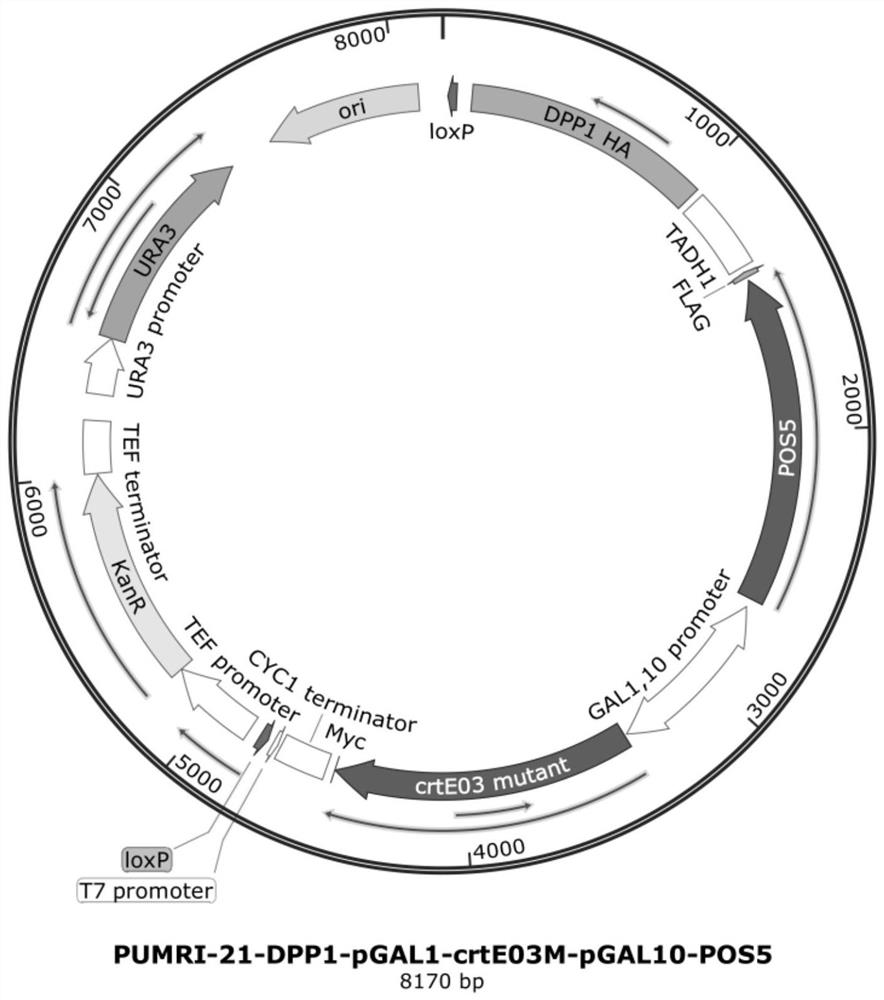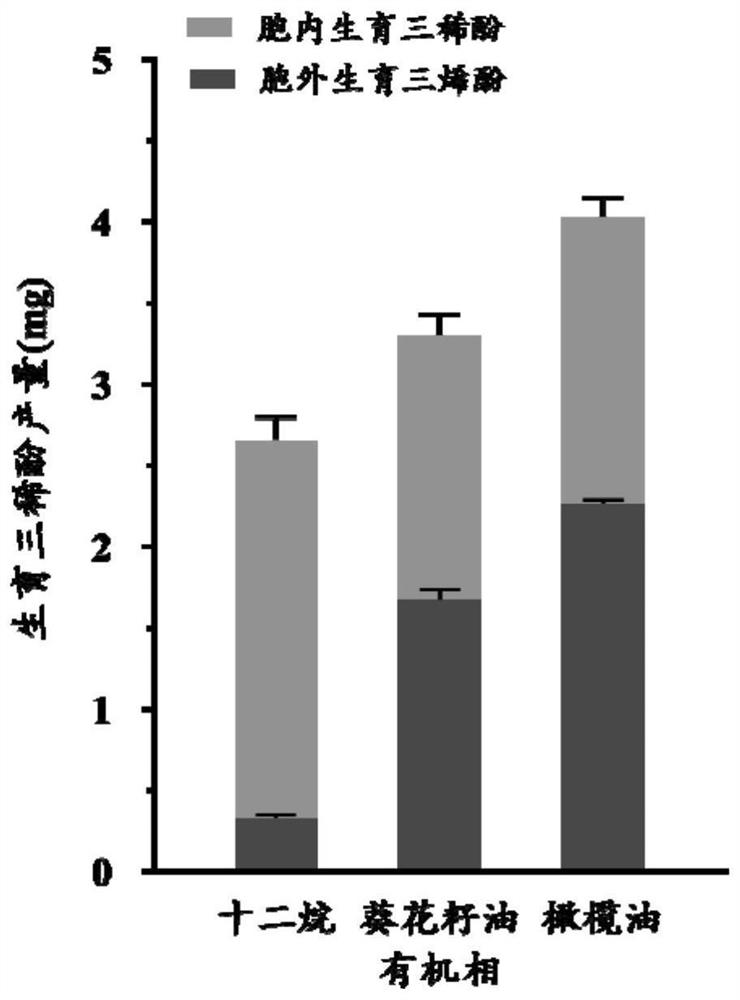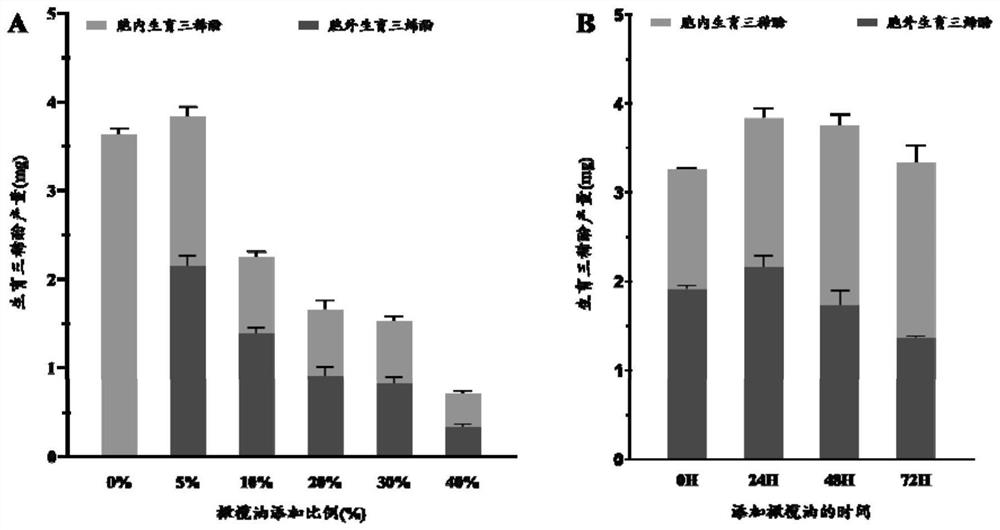Genetically engineered bacterium for exocytosis of tocotrienols and application of genetically engineered bacterium
A technology of tocotrienol and genetically engineered bacteria, which is applied in the fields of genetic engineering and metabolic engineering, can solve the problems of no reports of tocotrienol transporters, achieve good application prospects, and promote the effect of extracellular secretion
- Summary
- Abstract
- Description
- Claims
- Application Information
AI Technical Summary
Problems solved by technology
Method used
Image
Examples
Embodiment 1
[0034] Extraction and detection of tocotrienols in fermentation broth and organic phase.
[0035] 1. The specific method for extracting tocotrienols in Saccharomyces cerevisiae is as follows:
[0036] (1) Take 1 mL of yeast fermentation broth, centrifuge at 12000 rpm for 2 min, discard the supernatant, then wash twice with 2 mL of distilled water, discard the supernatant by centrifugation, add 200 μL of distilled water, and resuspend the bacteria;
[0037] (2) Add 500mL of grinding beads (0.1mm and 0.5mm zirconia beads in half) into a 2mL centrifuge tube, and then transfer all the resuspended bacterial solution to a 2mL centrifuge tube;
[0038] (3) Place the centrifuge tube containing the beads and bacteria in a fully automatic sample rapid grinder at 65HZ for 5 min;
[0039] (4) After grinding, place the centrifuge tube in a centrifuge at 4°C at 12000rpm, centrifuge for 10min, and discard the supernatant;
[0040] (5) Add 1 mL of acetone to the centrifuge tube for extraction...
Embodiment 2
[0049] Construction of a high-producing tocotrienol strain.
[0050] The phylloylgeranyl pyrophosphate synthase gene mutant (CrtE03M, GeneBank No. DQ016502.1) and the mitochondrial NADH kinase gene (POS5, GeneBank No. NM_001184002.1) derived from Phaffia rhodozyma were cloned into the yeast integrative type On the plasmid PUMRI-21-DPP1, the integrated plasmid PUMRI-21-DPP1 is to clone the coding gene of DPP1 into the SfiI site of the plasmid PUMRI-21. For details, please refer to the patent, the application number is CN201510001391.3. Use the following primers:
[0051] CrtE03M-F-BamHI: CGGGATCCATGGATTACGCGAACATCCTC,
[0052] CrtE03M-R-SalI: ACGCGTCGACTCACAGAGGGATATCGGCTAG,
[0053] POS5-R-SpeI: CTAGACTAGTTTAATCATTATCAGTCTGTCTCTTG,
[0054] POS5-F-NotI: ATAAGAATGCGGCCGCATGTTTGTCAGGGTTAAATTG.
[0055] Using genomic DNA as a template, high-fidelity enzyme (Prime START HS DNA polymerase) was used for PCR amplification. The reaction system (50μL) is as follows:
[0056]
...
Embodiment 3
[0063] Optimization of in situ extraction conditions of tocotrienols.
[0064] Add 5% (v / v) dodecane or sunflower oil or olive oil to the medium, and analyze the tocotrienol production and secretion ratio of the engineering strain ( figure 2 ), confirming that olive oil is an ideal extractant of tocotrienols. In order to further promote the secretion of tocotrienols, the amount and time of adding olive oil were optimized, adding 5%, 10%, 20%, 30%, 40% (v / v) olive oil or A two-phase fermentation system of strain YVT17 was established by adding 5% (v / v) olive oil as in-situ extractant at different time periods. After culturing for 96 hours, the fermentation broth was collected by centrifugation, and the organic phase was directly diluted 10-30 times with acetone for HPLC detection. The results showed that the extracellular secretion ratio of tocotrienols reached 56.12%, and compared with single-phase culture, the total tocotrienol production increased by 5.51% ( image 3 ). ...
PUM
 Login to View More
Login to View More Abstract
Description
Claims
Application Information
 Login to View More
Login to View More - R&D Engineer
- R&D Manager
- IP Professional
- Industry Leading Data Capabilities
- Powerful AI technology
- Patent DNA Extraction
Browse by: Latest US Patents, China's latest patents, Technical Efficacy Thesaurus, Application Domain, Technology Topic, Popular Technical Reports.
© 2024 PatSnap. All rights reserved.Legal|Privacy policy|Modern Slavery Act Transparency Statement|Sitemap|About US| Contact US: help@patsnap.com










